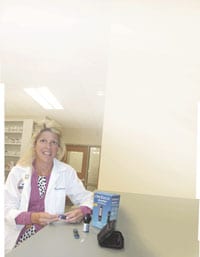Safe Passage Smart Technology Lowers the Risk for Problem Pregnancies
Dr. Glenn Markenson paused before having his picture taken.
“You could take one of our pa-tients instead,” he joked. “They’re pretty bored.”
And why wouldn’t they be? He was referring to the few women spending days and even weeks in the Wesson childbirth unit at Baystate Medical Center. Whether a case of multiple births, or early contractions, or some problem with the fetus that requires constant monitoring, there’s not a lot these patients can do to relieve the monotony.
At least they can take comfort in the fact that at-risk pregnancies, thanks to modern technology and medical know-how, are much less risky than in decades past.
“For those patients getting monitored, the risk of fetal death has significantly decreased, almost to the point where the unmonitored patients now have a higher risk because we don’t monitor them,” said Markenson, director of Maternal Fetal Medicine at Baystate, which, as a tertiary care hospital, serves as the referral point for risky pregnancies in Western Mass.
“It’s not common to have a fetal death because we intervene early. There may be complications with a pre-term birth, but it’s not very common. Diabetes babies used to die all the time in utero; now, it’s rare.”
Part of the reason is a cutting-edge, interactive fetal-monitoring system known as IPROB, or Intelligent Patient Record for Obstetrics. Baystate is one of a few dozen hospitals nationwide to use the technology, which essentially functions as an interactive obstetrics chart for physicians and nurses, with paper charts eliminated and replaced by a central computer database.
This month, The Healthcare News takes a look at IPROB, and how it — along with other measures — is keeping both mothers and babies safer than ever before.
Plugged In
The first thing one notices about IPROB is the lack of paper.
Every time a patient is examined or tested, and before they are given medication, the data is entered into the on-screen chart. Each doctor or nurse must enter a password to gain entry, and any data that has been added is stored permanently.
In addition, to ensure a safe birth, IPROB monitors all maternal and fetal parameters throughout the delivery process, including blood pressure, fetal heart rate, and the mother’s heart rate.
Just as important, IPROB contains a knowledge base of more than 6,500 best-practice guidelines and rules in obstetrics. The system accurately understands the clinical situation of the patient at any given moment, and is therefore able to recognize the actions and diagnoses the staff need to perform in order to provide the best care.
Dr. Eyal Ephrat, an obstetrician and CEO of E&C Medical Intelligence, the Israel-based company that developed the technology, touted the safeguards inherent in the system in an interview with pregnancy.com.
For example, “if pitocin [a labor-inducing drug] is administered to stimulate and enhance labor, IPROB would monitor the labor pattern and progression, as well as the baby’s well-being, and alert the doctors and nurses if pitocin levels become too high and contractions become too frequent,” he said. “The IPROB system would react before the baby became distressed.”
IPROB also reminds doctors if they have failed to enter vital data: if they have done something contraindicated by accepted practice, they must enter a formal explanation for their actions. According to one E&C developer, “it’s like having my oldest, most trusted colleague standing over my shoulder and supporting my case-management quality at every turn.”
For example, according to the Israel Ministry of Foreign Affairs Web site (www.mfa.gov.il), in 2001, an American nurse was told to administer pitocin to a pregnant woman. When the nurse entered the information in the IPROB computer at the patient’s bedside, the program refused to let her administer the drug. She soon realized that the patient was in her 26th week of pregnancy, with premature contractions, and pitocin would have tragically ended her pregnancy. An investigation into the cause of the confusion revealed a mixup in patient names.
E&C claims that, on average, IPROB successfully prevents a mistake in 1 in 9.5 deliveries. “It is in those critical moments they may fail to correctly realize the entire clinical picture, and become blinded to factors essential to providing the appropriate care,” Ephrat said. “This is when most errors occur and when it’s most critical to prevent them.”
Safety First
Nancy Rines, unit manager in Baystate’s tertiary care unit, demonstrated to The Healthcare News how IPROB works. Only one mother-to-be was hooked up that day — heart rate and contractions clearly within the proper margins — but all women in labor, normal and at-risk pregnancies alike, are monitored by the system, so the screen is often much more active.
And who are the at-risk population?
“Any number of things can happen,” Markenson said. “A patient may have a family history of a problem, or there may be an ultrasound finding at the doctor’s office, or the mother might be exposed to problems such as infection. Does the baby have that problem? Is the baby at risk? We can confirm or deny that, and most of the time, everything is fine.”
Those who require extra attention — whether or not they become longer-term inpatients — vary widely in their health issues. A handful of cases — 10 to 15 a year, mostly involving cardiac problems — are transferred to Boston for more specialized care, but Baystate handles the rest.
“A fair amount of people are substance abusers, and there are fetal anomalies, when something is wrong with the baby,” Rines said. “Some women are pregnant at an advanced age, while some patients have received no prenatal care. When you’re eight months pregnant and you haven’t seen anyone, that’s cause for concern.”
“There is a big methadone population here,” Markenson added. “If they’re only taking methadone itself, there’s a risk of the baby being born addicted, but it’s not strongly associated with birth defects. They’re typically smaller babies, and the long-term impact is not 100{06cf2b9696b159f874511d23dbc893eb1ac83014175ed30550cfff22781411e5} known.
The problem with methadone, he continued, is that many times the user is also smoking or taking street drugs, and that combination could pose serious dangers. “Still, if controlled, those people do reasonably well.”
That’s why perhaps the greatest risk, especially for mothers who have other health issues, is not seeking prenatal care early on.
“It’s a problem if they have diabetes or high blood pressure, or if they’re using drugs, and we missed every opportunity to provide prenatal care,” he said, adding that mothers without such issues who haven’t sought care still usually turn out healthy babies, although getting plenty of care early on is certainly ideal.
“Sometimes they have problems accessing the system,” he said, “but a lot of times they’re teenagers trying to hide it from everyone. It’s a problem.”
Rines added that Baystate also sees a lot of preterm labor, which is classified as before the 37-week mark.
“We evaluate whether we can stop the labor or if we have to proceed with the delivery,” she said. “The NICU attends all the high-risk deliveries. Neonatologists come down prior to the delivery and talk to mom about what to expect, tell them what the outcome will be like. They’re very realistic, and they’re excellent at what they do.”
Part of Baystate’s success, Rines said, is an emphasis on a team culture. “Essentially, anyone, from an obstetrician to someone on the birthing staff, can stop the birth. The mentality is that, if anyone sees something going wrong, we don’t have a culture here where people say, ‘that’s not your patient; don’t worry about that.’”
The Waiting Game
When it comes to pregnancy and childbirth, there’s plenty to be anxious about, however. An added challenge for doctors is the simple fact that women are waiting longer to give birth.
In 1970, the average American mother gave birth to her first child at age 21. By this decade, that figure had risen to 25, and the percentage of women having children into their 40s — when the risks of complications and chromosomal defects are higher — has steadily risen over the years.
But Markenson is confident that the modern medical technology is making the experience safer and less worrisome for expectant mothers, even those for whom the simple fact of their age puts them in a riskier class. Not every story ends well, but the outlook, generally, is much sunnier in these difficult cases than they were in years past.
“The emotions are so charged, but we’re lucky most of the time that everything is OK,” he said. “The highs are great, and the lows are tough. But it’s a privilege to be invited into these people’s lives for these most intimate moments. We’re lucky to be able to do that.”



